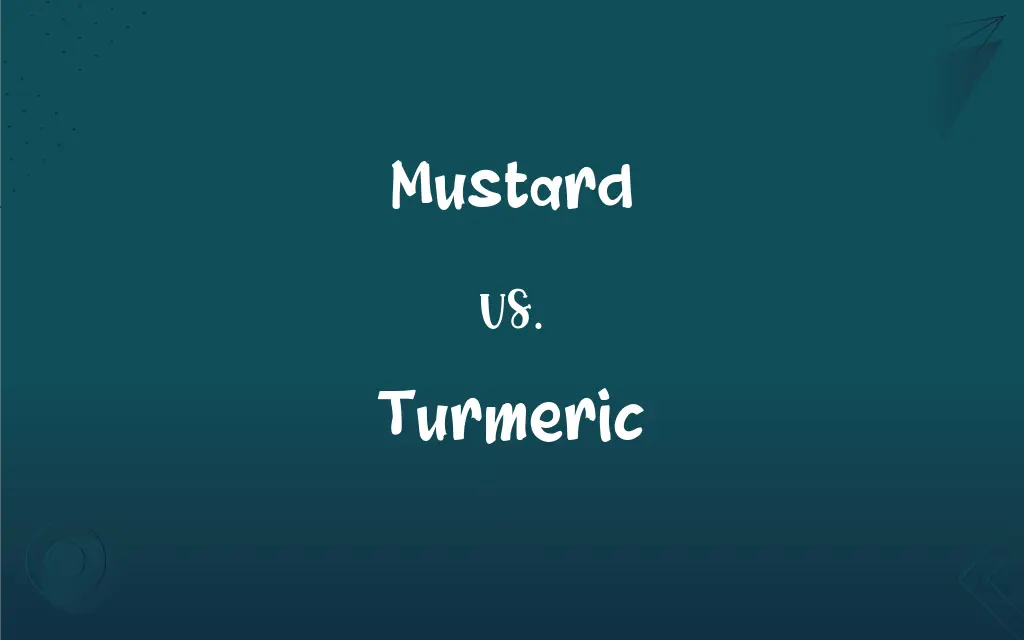Mustard vs. Turmeric: What's the Difference?
Edited by Harlon Moss || By Janet White || Updated on October 6, 2023
Mustard is a condiment made from the seeds of a mustard plant, offering a spicy flavor, while turmeric is a golden spice, derived from the root of the Curcuma longa plant, known for its warm, bitter taste and vibrant color. They differ in flavor, color, a

Key Differences
Mustard is a well-known condiment derived from the seeds of the mustard plant, often used to enhance the flavor of various dishes with its distinct spicy taste. It can be found in different varieties, such as yellow, brown, or Dijon, each providing a unique flavor profile to foods. Turmeric, on the other hand, is a spice obtained from the root of the Curcuma longa plant, notable for its characteristic golden color and warm, bitter taste. It's widely used in culinary applications, particularly in South Asian cuisine, for flavoring and coloring dishes, and is renowned for its potential health benefits due to its active ingredient, curcumin.
When considering the culinary applications of mustard and turmeric, they each have their distinctive uses. Mustard is versatile and can be used as a condiment, in dressings, marinades, sauces, and even to spice up dishes like grilled meats or sandwiches. It adds a pungent, often spicy flavor to foods. Turmeric, conversely, is typically used as a cooking spice, predominantly in curries and rice dishes, to impart a warm, mildly bitter flavor and a vibrant yellow color. It is a staple in many recipes, especially in Indian cuisine, enhancing the overall taste and appearance of the dishes.
Mustard and turmeric also hold significant places in traditional medicine. Mustard has been used for its supposed healing properties, including its potential to alleviate respiratory conditions and its role as a topical treatment for pain and inflammation. Turmeric has been hailed for its anti-inflammatory, antioxidant, and potential anti-cancer properties, often used as a dietary supplement to address a variety of health concerns, from digestive issues to inflammatory conditions like arthritis.
In terms of availability and forms, mustard can be procured as seeds, powder, or prepared condiment, offering diverse application possibilities in culinary arts. Turmeric is commonly available in powder form, but fresh turmeric root is also used in cooking and medicinal preparations. While both mustard and turmeric have made substantial contributions to world cuisine and natural medicine, their distinct flavors, colors, and applications define their unique roles in culinary and medicinal realms.
Comparison Chart
Source
Seeds of the mustard plant.
Root of the Curcuma longa plant.
ADVERTISEMENT
Flavor
Spicy and pungent.
Warm, bitter, and mildly aromatic.
Color
Yellow, brown, or golden.
Vibrant golden-yellow.
Culinary Use
Condiment, dressing, marinade.
Spice for flavoring and coloring dishes.
Health Benefits
May alleviate respiratory conditions, anti-inflammatory.
Anti-inflammatory, antioxidant, and potential anti-cancer properties.
Mustard and Turmeric Definitions
Mustard
A plant of the Brassica genus, with yellow flowers, and pungent seeds.
Mustard plants are a common sight in agricultural fields.
ADVERTISEMENT
Turmeric
A herbaceous perennial plant of the ginger family.
Turmeric plants thrive in warm, humid climates.
Mustard
A paste or sauce made from mustard seeds used in cooking.
He used mustard to marinate the chicken before grilling.
Turmeric
A natural dye used for coloring fabrics and foods.
He used turmeric to dye the fabric a golden yellow.
Mustard
A spicy condiment made from crushed mustard seeds.
She added mustard to her sandwich for extra flavor.
Turmeric
A culinary spice known for its warm, bitter taste.
He seasoned the rice with a pinch of turmeric.
Mustard
A vibrant yellow color resembling the hue of prepared mustard.
She wore a dress of a bright mustard shade.
Turmeric
A medicinal spice known for its anti-inflammatory properties.
She takes turmeric supplements for her joint pain.
Mustard
Any of various Eurasian plants of the mustard family, especially white mustard, Indian mustard, and black mustard, which are cultivated for their pungent seeds and edible leaves.
Turmeric
A yellow spice obtained from the root of the Curcuma longa plant.
She added turmeric to the curry for color and flavor.
Mustard
A condiment made from the powdered seeds of certain of these plants.
Turmeric
A widely cultivated tropical plant (Curcuma longa) of India, having yellow flowers and an aromatic, somewhat fleshy rhizome.
Mustard
A member of the mustard family.
Turmeric
The powdered rhizome of this plant, used as a spice and a yellow dye.
Mustard
A dark yellow to light olive brown.
Turmeric
Any of several other plants having similar rhizomes.
Mustard
Any of a group of toxic organic compounds that include mustard gas and the nitrogen mustards.
Turmeric
(botany) An Indian plant, Curcuma longa, with aromatic rhizomes, part of the ginger family (Zingiberaceae).
Mustard
A plant of certain species of the genus Brassica, or of related genera (especially Sinapis alba, in the family Brassicaceae, with yellow flowers, and linear seed pods).
Turmeric
(cooking) The pulverized rhizome of the turmeric plant, used for flavoring and to add a bright yellow color to food.
Mustard
Powder or paste made from seeds of the mustard plant, and used as a condiment or a spice.
When the waitress brought the food, I asked whether she had any Dijon mustard.
Turmeric
A yellow to reddish-brown dye extracted from the turmeric plant.
Mustard
The leaves of the mustard plant, used as a salad.
Mustard and cress sandwiches.
Turmeric
An East Indian plant of the genus Curcuma, of the Ginger family.
Mustard
Dark yellow colour, the colour of mustard.
Turmeric
The root or rootstock of the Curcuma longa. It is externally grayish, but internally of a deep, lively yellow or saffron color, and has a slight aromatic smell, and a bitterish, slightly acrid taste. It is used for a dye, a medicine, a condiment, and a chemical test.
Mustard
One of a family of vesicants containing one or more 2-chloroethyl (C2H4Cl) groups, commonly used in chemical warfare and cancer chemotherapy.
Turmeric
Of or pertaining to turmeric; resembling, or obtained from, turmeric; specif., designating an acid obtained by the oxidation of turmerol.
Mustard
The tomalley of a crab, which resembles the condiment.
Turmeric
Widely cultivated tropical plant of India having yellow flowers and a large aromatic deep yellow rhizome; source of a condiment and a yellow dye
Mustard
Of a dark yellow colour.
Turmeric
Ground dried rhizome of the turmeric plant used as seasoning
Mustard
The name of several cruciferous plants of the genus Brassica (formerly Sinapis), as white mustard (Brassica alba), black mustard (Brassica Nigra), wild mustard or charlock (Brassica Sinapistrum).
Mustard
A powder or a paste made from the seeds of black or white mustard, used as a condiment and a rubefacient. Taken internally it is stimulant and diuretic, and in large doses is emetic.
Mustard
Any of several cruciferous plants of the genus Brassica
Mustard
Pungent powder or paste prepared from ground mustard seeds
Mustard
Leaves eaten as cooked greens
Mustard
A powder made from ground mustard seeds.
She mixed mustard powder with vinegar to prepare homemade mustard sauce.
FAQs
Is turmeric a spice?
Yes, turmeric is a golden spice derived from the root of the Curcuma longa plant.
Is mustard a condiment?
Yes, mustard is a widely used condiment made from the seeds of a mustard plant.
Does mustard have a spicy flavor?
Yes, mustard typically has a spicy, pungent flavor.
Can mustard be used in marinades?
Indeed, mustard is often used in marinades to add flavor to meats.
Can mustard be available in powder form?
Yes, mustard can be bought as a powder, as seeds, or as a prepared condiment.
Is turmeric a staple in Indian cuisine?
Absolutely, turmeric is a staple spice in Indian cuisine, used in a variety of dishes.
Can mustard seeds be used for pickling?
Yes, mustard seeds are often used in pickling for their pungent flavor.
Can turmeric be used for coloring?
Absolutely, turmeric is often used to impart a vibrant golden-yellow color to dishes.
Can turmeric stain fabrics?
Yes, turmeric can leave a persistent yellow stain on fabrics and surfaces.
Does turmeric have medicinal properties?
Yes, turmeric is known for its anti-inflammatory, antioxidant, and potential anti-cancer properties.
Is mustard available in different varieties?
Yes, mustard is available in different varieties like yellow, brown, and Dijon, each with unique flavors.
Does mustard have any medicinal uses?
Yes, mustard has been used traditionally to alleviate various conditions like respiratory ailments.
Can turmeric be consumed as a supplement?
Yes, turmeric is available in supplement form for its potential health benefits.
Can mustard alleviate inflammatory conditions?
There is some evidence suggesting that mustard can have anti-inflammatory effects.
Is turmeric used in traditional medicine?
Yes, turmeric has been used in traditional medicine for its numerous health benefits.
About Author
Written by
Janet WhiteJanet White has been an esteemed writer and blogger for Difference Wiki. Holding a Master's degree in Science and Medical Journalism from the prestigious Boston University, she has consistently demonstrated her expertise and passion for her field. When she's not immersed in her work, Janet relishes her time exercising, delving into a good book, and cherishing moments with friends and family.
Edited by
Harlon MossHarlon is a seasoned quality moderator and accomplished content writer for Difference Wiki. An alumnus of the prestigious University of California, he earned his degree in Computer Science. Leveraging his academic background, Harlon brings a meticulous and informed perspective to his work, ensuring content accuracy and excellence.































































